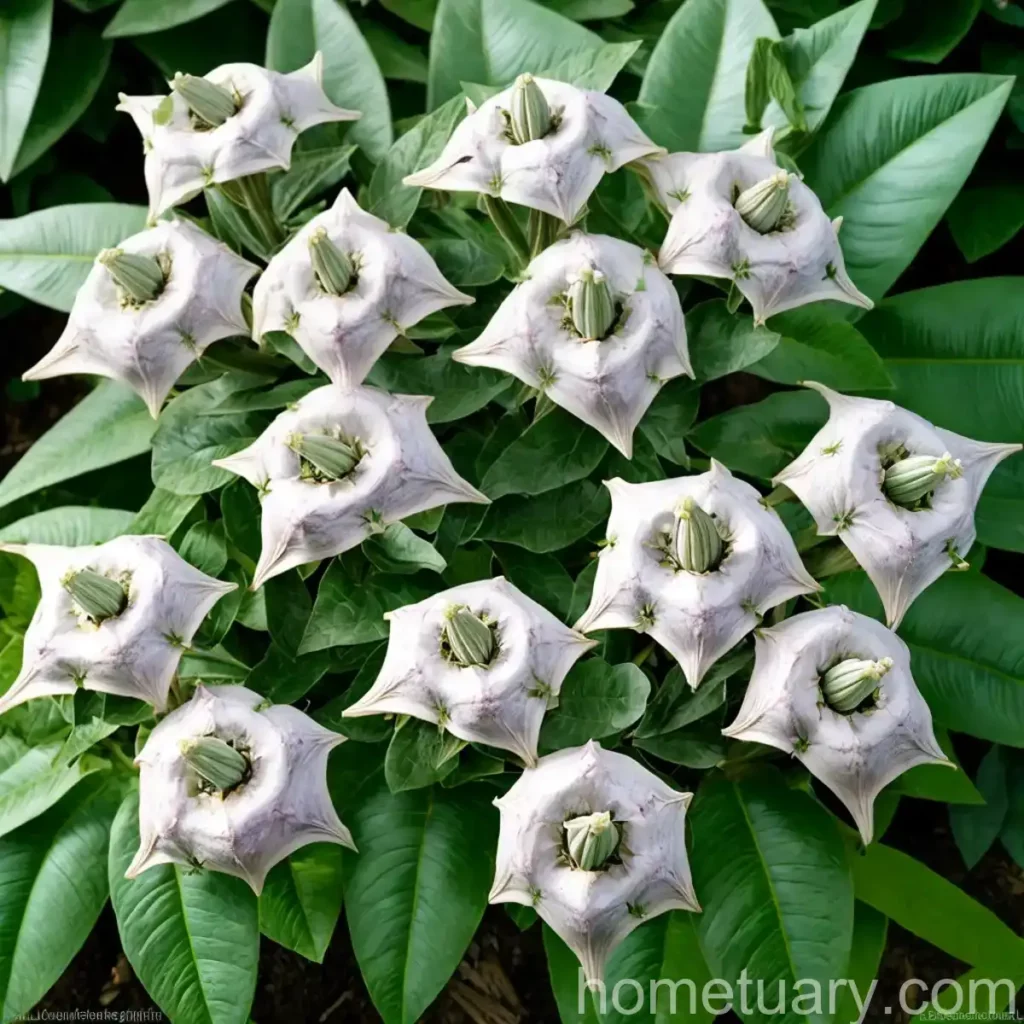Giant Milkweed (Calotropis gigantea): A Comprehensive Guide
Introduction
As a plant scientist, I am excited to delve into the fascinating world of giant milkweed, scientifically known as Calotropis gigantea. This extraordinary plant has garnered attention due to its cultural significance, ecological importance, and various uses in landscaping and traditional medicine. In this article, I will provide an in-depth exploration of giant milkweed, covering its cultivation, benefits, ecological impact, and much more. Let’s begin this exploration by understanding what giant milkweed is and its key takeaways.
What is Giant Milkweed (Calotropis gigantea)?
Giant milkweed, also known as Crown Flower, is a perennial shrub that belongs to the Apocynaceae family. Native to Southeast Asia and parts of Australia, this plant has become naturalized in several tropical and subtropical regions across the globe. Calotropis gigantea is renowned for its striking appearance, with large, showy flowers that range in color from white to lavender and deep purple. The plant can reach heights of up to 3 meters (approximately 10 feet) and features broad, lance-shaped leaves.
Key Takeaways – Giant Milkweed (Calotropis gigantea)
Before we delve deeper into the intricacies of giant milkweed, let’s highlight the key takeaways associated with this remarkable plant:
- Botanical Name: Calotropis gigantea
- Common Names: Giant milkweed, Crown Flower
- Uses: Medicinal, landscaping, ecological conservation
- Cultural Significance: Utilized in traditional rituals and crafts
- Ecological Impact: Attracts pollinators, serves as a butterfly host plant
- Cultivation: Suitable for warm climates, drought-tolerant
- Challenges: Sensitive to frost, may be invasive in some regions
- Propagation: Can be grown from seeds or stem cuttings
- Unique Features: Latex-filled stems, distinctive seed pods
- Caution: Contains toxic compounds, especially in the sap
Now that we have an overview of giant milkweed, let’s explore its cultivation requirements and how it can be utilized in various settings.
Culture
Cultivating giant milkweed requires an understanding of its specific requirements to ensure optimal growth and development. From sunlight exposure to soil composition, each aspect plays a crucial role in the plant’s overall well-being. Let’s delve into the cultural aspects of cultivating Calotropis gigantea.
Uses
Giant milkweed offers a multitude of uses, ranging from its traditional medicinal properties to its application in landscaping and ecological conservation efforts.
Medicinal Uses
In traditional medicine, various parts of the giant milkweed plant, including the roots, leaves, and latex, are utilized for their medicinal properties. The plant is known for its potential anti-inflammatory, antimicrobial, and analgesic effects. Additionally, it has been used in the treatment of conditions such as rheumatism and skin ailments. However, it’s essential to exercise caution due to the plant’s toxicity.
Landscaping
Giant milkweed’s striking appearance makes it a popular choice for landscaping projects, particularly in tropical and subtropical regions. Its large, showy flowers and attractive foliage contribute to its appeal as an ornamental plant. Moreover, its ecological benefits, such as attracting pollinators and serving as a host plant for butterflies, further enhance its desirability in landscaping.
Ecological Conservation
Due to its ability to attract pollinators and support butterflies, giant milkweed plays a vital role in ecological conservation efforts. As a native plant in certain regions and naturalized in others, it contributes to biodiversity and ecosystem stability. Its role in supporting wildlife and enhancing natural habitats underscores its ecological importance.
Water
Giant milkweed thrives in well-draining soil and prefers moderate water levels. While it can tolerate dry spells and is considered drought-tolerant once established, regular watering is recommended, especially during the plant’s initial growth stages. However, it is essential to avoid overwatering, as excessive moisture can lead to root rot and other issues.
Sunlight
As a sun-loving plant, giant milkweed flourishes in full sunlight. It requires at least six hours of direct sunlight daily to thrive and produce an abundance of flowers. When selecting a planting site, it is crucial to ensure that the plant receives adequate sun exposure to support its growth and blooming capabilities.
Fertilizer
When it comes to fertilization, giant milkweed exhibits low to moderate nutrient requirements. A balanced, slow-release fertilizer can be applied during the growing season to provide essential nutrients for healthy growth and flowering. It’s important to follow the recommended application rates and avoid over-fertilization, which can lead to excessive foliage growth at the expense of flower production.
Soil
Giant milkweed prefers well-drained, slightly acidic to neutral soil. It can adapt to various soil types, including sandy and loamy soils, as long as they provide good drainage. Amending the soil with organic matter can enhance its quality and structure, promoting favorable growing conditions for the plant.
Pruning
Pruning giant milkweed can help maintain its shape, remove dead or damaged foliage, and stimulate new growth. It is advisable to prune the plant after the flowering period to encourage a compact form and prevent it from becoming overly leggy. Additionally, removing spent flowers and seed pods can divert the plant’s energy back into vegetative growth and flowering.
Propagation
Giant milkweed can be propagated from seeds or stem cuttings. Both methods have their distinct advantages and can be employed based on the desired propagation outcomes. Seed propagation allows for genetic diversity, while stem cuttings offer a quicker and more reliable method of reproducing the plant.
Container Popularity
The striking appearance and manageable size of giant milkweed make it a popular choice for container gardening. Its ability to thrive in a container setting offers versatility for individuals with limited garden space or those seeking to create captivating displays on patios, balconies, or outdoor living areas.
Common Diseases
Like many plants, giant milkweed is susceptible to certain diseases that can impact its overall health and vitality. Understanding these common diseases and their associated symptoms is crucial for effective management and prevention.
Disease Diagnosis
One of the most prevalent diseases affecting giant milkweed is leaf spot, which presents as circular lesions on the foliage. These lesions may vary in color from brown to black and can lead to defoliation if left untreated. Additionally, fungal diseases such as powdery mildew and sooty mold can occur, resulting in a white powdery or dark, velvety growth on the leaves.
Proper diagnosis of these diseases is essential for implementing targeted control measures. By identifying the specific disease affecting the plant, appropriate fungicidal treatments and cultural practices can be employed to manage the issues effectively.
Common Pests
In addition to diseases, giant milkweed can be susceptible to certain pests that can compromise its growth and aesthetics. Being aware of these common pests and their characteristic signs is instrumental in maintaining a healthy plant.
Botanist’s Tips
As a botanist, I would like to offer some valuable tips for cultivating and caring for giant milkweed:
- Cautionary Note: Handle the plant with care, especially when pruning or handling cuttings, as the milky latex sap can be irritating to the skin and eyes.
- Beneficial Insects: Encourage the presence of beneficial insects, such as ladybugs and lacewings, to help naturally control pest populations on the plant.
- Companion Planting: Consider companion planting with species that support pollinators and beneficial insects, creating a favorable environment for giant milkweed and enhancing overall garden health.
Fun Facts
To add an element of intrigue to our exploration of giant milkweed, here are some fascinating fun facts about this extraordinary plant:
- The large, globe-shaped seed pods of giant milkweed are often used in decorative crafts and floral arrangements.
- In some cultures, giant milkweed is employed in traditional rituals and ceremonies, symbolizing various aspects of spirituality and folklore.
- The plant’s latex sap, while toxic, has been historically used in some regions for its potential insecticidal properties and as a source of natural rubber.
Links to External Resources
For further information on giant milkweed and related topics, the following external resources provide valuable insights and details:
- Flora of China – Calotropis gigantea
- Medicinal Plants of Asia and the Pacific
- Butterfly Gardening Resources
- Ecological Importance of Native Plants
- Plant Propagation Techniques
In this comprehensive guide, we have delved into the captivating world of giant milkweed, encompassing its cultivation, uses, ecological significance, potential challenges, and intriguing fun facts. As a plant scientist, it is always a pleasure to uncover the diverse aspects of plants and their multifaceted roles in our lives and ecosystems. Whether utilized in landscaping, conservation efforts, or traditional practices, giant milkweed stands as a testament to the inherent value and richness of botanical diversity in our world.
As we continue to appreciate and learn from the plant kingdom, it is my hope that this guide has provided valuable insights and instilled a deeper appreciation for the remarkable Calotropis gigantea.















